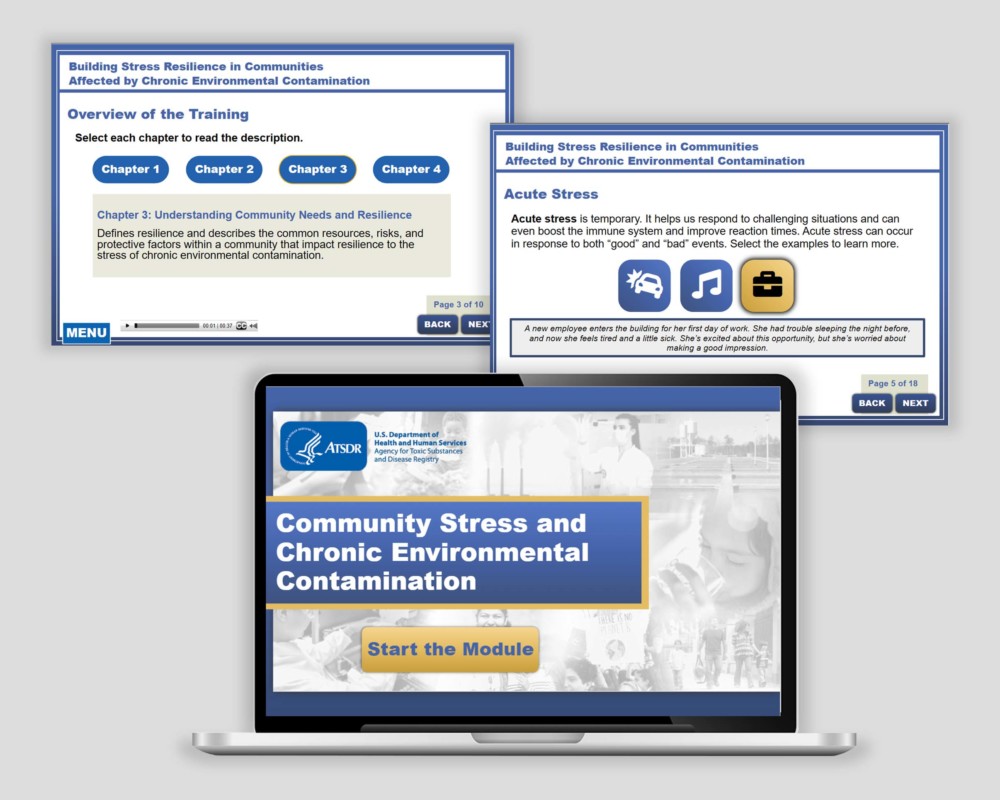ATSDR – Resource Center, Training Module, & Communications Support
CLIENTS:
Agency for Toxic Substances and Disease Registry (ATSDR)
ATSDR Community Stress Resource Center Creation
Ripple Effect’s Communications and Outreach team provided the CDC’s Agency for Toxic Substances and Disease Registry (ATSDR) with a comprehensive online Community Health Resource Center.
While communities that experience long-term environmental contamination often have increased psychological and social stress, chronic stress can have serious consequences on the community’s long-term health. Without proper guidance and tools, a public health response to environmental contamination can inadvertently add to community stress. Therefore, clear information needed to be easily accessible and interpreted by public health officials.
Ripple Effect met this challenge by developing a tailored resource center that offers targeted tools for public health workers to reduce community stress improve community resilience during a public health response. Ripple Effect developed the resource center from the ground up with a robust web architecture which unified ATSDR’s existing Per- and Polyfluoroalkyl Substances (PFAS) portfolio of work with new, custom-tailored content. Ripple Effect future-proofed the resource center by developing of a comprehensive style guide so future published resources meet the current contents high standards.
One major goal that Ripple Effect achieved was to create a seamless user experience. This was carried out through the implementation of efficient categories that are searchable by type, source, language and ATDSR’s 3 key framework goals – recognize, prepare, and partner. Additionally, Ripple Effects graphics communicate knowledge areas through over 40+ diverse resources to supply guidance to prevent, understand and address stress that public health responses to long-term environmental contaminations can inadvertently cause.
ATSDR Stress Training Module: Chronic Stress and Environmental Contamination
Ripple Effect created a training module for the Agency for Toxic Substances and Disease Registry (ATSDR) to educate public health officials on how chronic stress can be a serious problem, why it is normal for some community members to experience stress related to contamination and, how they can help mitigate stress and promote community resilience.
Communities which experience long-term environmental contamination often have increased psychological and social stress. While it is normal for some community members to experience stress in these situations, chronic stress can have serious consequences on the community’s long-term health. Without proper guidance and tools, the public health response to environmental contamination can inadvertently add to community stress.
Ripple Effects training solution leveraged Lectora, an eLearning development platform, to create a fully accessible, searchable, and engaging training module for public health professionals. This interactive training module is fully searchable and achieves heightened engagement by communicating ATDSR’s 3 key goals through two case studies: Lead Contamination in Los Angeles, CA and Asbestos Contamination in Libby, MT.
Supporting ATSDR’s Environmental Health Communications
Ripple Effect developed a training module and an online toolkit to support environmental health professionals’ work in communities experiencing chronic environmental contamination from PFAS and other toxic substances. The training addresses the unique characteristics of stress in communities affected by environmental contamination, while the toolkit/resource center provides guidance for professionals on how to communicate with community members to acknowledge their stress and help build community resilience.
We worked closely with ATSDR to incorporate scientific evidence on individual and community stress associated with these contamination events into these deliverables. Our work was especially focused on the compounding harm done by well-intentioned but poorly informed helpers and the value of emphasizing practices that build and sustain resiliency in these communities. The Stress 101 training module we developed helps environmental health professionals understand the links between contamination-related stress and long-term outcomes in these communities. The ATSDR Stress and Resilience Toolkit will help them navigate and apply the growing body of scientific findings and practical resources in this field. We also convened and facilitated a series of monthly meetings to enable key stakeholders to provide input on the design and content of the toolkit.






























